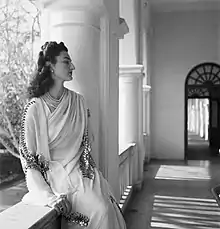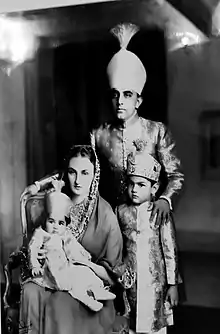Dürrüşehvar Sultan
Begum Sahiba Hatice Hayriye Ayşe Dürrüşehvar Sultan (Ottoman Turkish: خدیجه خیریه عائشه درشهوار سلطان; 26 January 1914 – 7 February 2006) was the daughter of Abdulmejid II of the Ottoman dynasty, who was the last heir apparent to the Ottoman Imperial throne and the last Caliph of the Ottoman Caliphate. She held the titles of Princess of Berar through marriage, and Imperial Princess of the Ottoman Empire by birth before the monarchy's abolition in 1922.
| Dürrüşehvar Sultan | |||||
|---|---|---|---|---|---|
| Her Imperial Highness Dürrüşehvar Sultan Princess consort of Berar Imperial Princess of the Ottoman Empire | |||||
 | |||||
| Born | 26 January 1914 Çamlıca Palace, Üsküdar, Constantinople, Ottoman Empire (present day Istanbul, Turkey) | ||||
| Died | 7 February 2006 (aged 92) London, England | ||||
| Burial | |||||
| Spouse | Azam Jah | ||||
| Issue | Mukarram Jah Muffakham Jah | ||||
| |||||
| Dynasty | Ottoman (by birth) Asaf Jahi (by marriage) | ||||
| Father | Abdulmejid II | ||||
| Mother | Mehisti Hanım | ||||
| Religion | Sunni Islam | ||||
Early life

The princess was born at the Çamlıca Palace in Üsküdar, then part of Constantinople, when the Ottoman Caliphate was passing through its last phase. Her father, Caliph Abdülmecid II, went into exile in Paris, France, after the abolition of the Caliphate by Mustafa Kemal Atatürk in 1924.
Marriage
Upon the family's exile to France in 1924, she was sought by the Shah of Persia and King Fuad I of Egypt as a bride for their respective heirs, Mohammed Reza Pahlavi and Farouk, and by Prince Azam Jah (1907–1970), the eldest son and heir of the last Nizam of Hyderabad State, Osman Ali Khan, Asif Jah VII, whom she married in Nice, France, on 12 November 1932. Her first cousin Nilüfer, was married to Prince Moazzam Jah, the second son of the Nizam.

The marriage of the princess was performed, in the south of France, by the good offices of Maulana Shaukat Ali, brother of Maulana Muhammad Ali Johar, the leader of the Khilafat Movement in India. Dürrüşehvar was 18 at the time, and significantly taller than her husband of 25, Azam Jah. Her father-in-law, the Nizam loved pointing out how much taller she was than his son, at their parties.
It was believed at that time that the matrimonial alliance between the Nizam, the richest ruler in the world of his time, and the deposed Caliph would lead to the emergence of a Muslim ruler who could be acceptable to the world powers in place of the Ottoman sultans. Dürrüşehvar, whose father was raised by a branch of the Ottoman monarchy deeply interested in modernizing reforms and believed in modern education for women including his wives and daughter, became a popular public figure after her arrival in Hyderabad. She believed that women should earn their own living, and helped to remove the practice of purdah.
Social life
Highly respected and well-educated lady, the princess was fluent in French, Turkish, English and also Urdu. She also established a junior college for girls in her name, Bagh-e-jahan Ara, Yakutpura, Hyderabad.
She divided her time principally between Hyderabad and London, where she died, attended by her two sons.
Philip Mason, of the Indian Civil Service, described her as "a commanding figure, handsome of feature, with a clear fair complexion and auburn hair… No one could ignore her or slight her. She was always essentially and indefinably royal, and it seems to me that if fate had so willed she might have been one of the great queens of the world."[1]
Later life

Following the birth of her sons Prince Mukarram Jah in 1934 and Prince Muffakham Jah in 1939, she took charge of their upbringing, the two princes being educated in Britain but got them married to Turkish ladies. The last Nizam- (Mir Osman Ali Khan) later bypassed his own son and nominated her first son and his grandson, as his successor.
The Princess became the first woman to inaugurate an airport when she inaugurated the airport in Hyderabad in the 1940s. She is also credited with inaugurating the Osmania General Hospital. She set up the Durru Shehvar Children's & General Hospital for women and children in the old city of Hyderabad. She also inaugurated the famous Ajmal Khan Tibbiya College Hospital at Aligarh Muslim University, Aligarh in 1939. Her last public appearance in the city was when she presided over the opening ceremony of the Nizam's Silver Jubilee Museum in 2000. She last visited Hyderabad in 2004.
She was upset about Turkish Government's attitude against her family members after declaration of the republic. Despite being a member of Ottoman royal family she refused to be buried in Turkey since she was upset that the Turkish Government refused in 1944 her father's burial in Istanbul.[2]
Ancestry
| Ancestors of Dürrüşehvar Sultan | |||||||||||||||||||||||||||||||||||||||||||||||||||||||||||||||||||||||||||||||||||||||||||||||||||||||||||||||||||||||||||||||||||||||||||||||||||||||||||||||||||||||||||||||||||||||||||||||||||||||||||||||||||||||||||||||||||||||||||||||||||||||||||||||||||||||||||||||||||||||||||||||||||||||||||||||||||||||||||||||||||||||||||||||||||||||||||||||||||||||||||||||||||||||||||||||||||||||||||||||||||||||||||||||||||||||||||||||||||||||||||||||||||||||||||||||||||||||||||||||||||||||||||||||||||||||||||||||||||||||||||||||||||||||||||||
|---|---|---|---|---|---|---|---|---|---|---|---|---|---|---|---|---|---|---|---|---|---|---|---|---|---|---|---|---|---|---|---|---|---|---|---|---|---|---|---|---|---|---|---|---|---|---|---|---|---|---|---|---|---|---|---|---|---|---|---|---|---|---|---|---|---|---|---|---|---|---|---|---|---|---|---|---|---|---|---|---|---|---|---|---|---|---|---|---|---|---|---|---|---|---|---|---|---|---|---|---|---|---|---|---|---|---|---|---|---|---|---|---|---|---|---|---|---|---|---|---|---|---|---|---|---|---|---|---|---|---|---|---|---|---|---|---|---|---|---|---|---|---|---|---|---|---|---|---|---|---|---|---|---|---|---|---|---|---|---|---|---|---|---|---|---|---|---|---|---|---|---|---|---|---|---|---|---|---|---|---|---|---|---|---|---|---|---|---|---|---|---|---|---|---|---|---|---|---|---|---|---|---|---|---|---|---|---|---|---|---|---|---|---|---|---|---|---|---|---|---|---|---|---|---|---|---|---|---|---|---|---|---|---|---|---|---|---|---|---|---|---|---|---|---|---|---|---|---|---|---|---|---|---|---|---|---|---|---|---|---|---|---|---|---|---|---|---|---|---|---|---|---|---|---|---|---|---|---|---|---|---|---|---|---|---|---|---|---|---|---|---|---|---|---|---|---|---|---|---|---|---|---|---|---|---|---|---|---|---|---|---|---|---|---|---|---|---|---|---|---|---|---|---|---|---|---|---|---|---|---|---|---|---|---|---|---|---|---|---|---|---|---|---|---|---|---|---|---|---|---|---|---|---|---|---|---|---|---|---|---|---|---|---|---|---|---|---|---|---|---|---|---|---|---|---|---|---|---|---|---|---|---|---|---|---|---|---|---|---|---|---|---|---|---|---|---|---|---|---|---|---|---|---|---|---|---|---|---|---|---|---|---|---|---|---|---|---|---|---|---|---|---|---|---|---|---|---|---|---|---|---|---|---|---|---|---|---|---|---|---|---|---|---|---|---|---|---|---|---|---|---|---|---|---|---|---|---|---|---|---|---|---|---|---|---|---|---|---|---|---|---|---|---|---|---|---|---|---|---|---|---|---|---|---|---|---|---|---|---|---|---|---|---|---|---|---|---|---|---|---|---|---|---|---|---|---|---|---|---|---|---|---|---|---|---|---|---|---|---|---|---|---|---|---|---|---|---|---|---|---|---|---|---|---|---|---|---|---|---|---|---|
| |||||||||||||||||||||||||||||||||||||||||||||||||||||||||||||||||||||||||||||||||||||||||||||||||||||||||||||||||||||||||||||||||||||||||||||||||||||||||||||||||||||||||||||||||||||||||||||||||||||||||||||||||||||||||||||||||||||||||||||||||||||||||||||||||||||||||||||||||||||||||||||||||||||||||||||||||||||||||||||||||||||||||||||||||||||||||||||||||||||||||||||||||||||||||||||||||||||||||||||||||||||||||||||||||||||||||||||||||||||||||||||||||||||||||||||||||||||||||||||||||||||||||||||||||||||||||||||||||||||||||||||||||||||||||||||
References
- "Princess Dürrühsehvar of Berar". 11 February 2006 – via www.telegraph.co.uk.
- Doğan, İbrahim (13–19 February 2006). "Türkiye'de gömülmek istemedi (She didn't want to be buried in Turkey.)". Aksiyon. Dosyalar ( Files ) (584).(Mainly in Turkish)
- Salnâme-i Devlet-i Âliyye-i Osmanîyye, 1333-1334 Sene-i Maliye, 68. Sene. Hilal Matbaası. 1918. p. 74-75.
External links
| Wikimedia Commons has media related to Dürrüşehvar Sultan. |